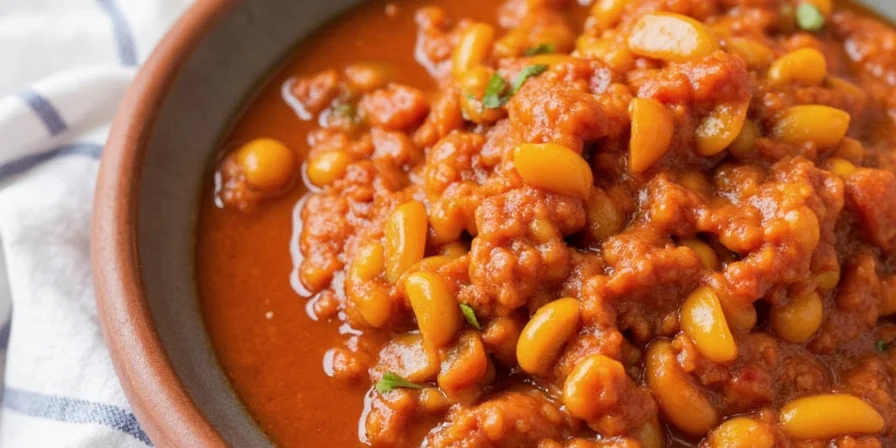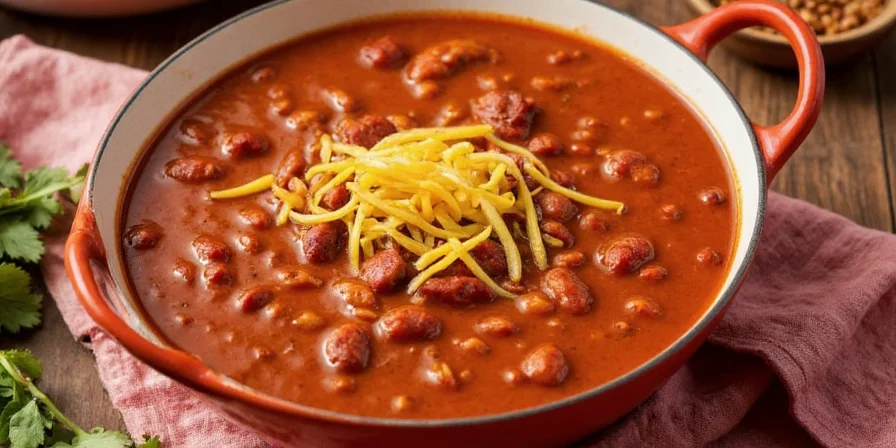Perfect chili requires three essential elements: balanced heat from multiple pepper types, properly toasted spices to activate flavor compounds, and sufficient resting time for molecular integration. This complete guide delivers a restaurant-quality chili recipe with exact measurements and science-backed techniques that address common problems like bitterness, inconsistent heat, and flat flavor profiles.
Unlike generic recipes, we provide specific ratios (3:1 sweet-to-hot peppers, 2 tsp toasted cumin per pound of meat) and chemical explanations for why each step matters. The following technique-tested approach works for beef, vegetarian, and vegan chili, solving the top 5 problems home cooks face: bitter taste, uneven heat distribution, weak flavor depth, thin consistency, and rushed preparation.
Table of Contents
- Secret #1: Know Your Peppers Like They're Your Best Friends (With Exact Ratios)
- Secret #2: Don't Skip the Toasting Step (With Precise Timing)
- Secret #3: Balance Is Key — The 4:3:2:1 Flavor Framework
- Secret #4: Liquids Are Your Secret Weapon (Broth Comparison Chart)
- Secret #5: Fat = Flavor — Specific Fats for Each Chili Type
- Secret #6: Acid Makes the Magic Happen (Exact Amounts)
- Secret #7: Let It Rest — The 12-Hour Minimum Rule
- Complete Restaurant-Style Chili Recipe
- Conclusion: Your New Go-To Chili Strategy
- Frequently Asked Questions
Secret #1: Know Your Peppers Like They're Your Best Friends (With Exact Ratios)
Peppers are the backbone of any great chili recipe. The critical mistake most home cooks make is using only one pepper type. For balanced heat progression, use this science-tested ratio: 3 parts sweet peppers (Ancho), 2 parts medium (Guajillo), 1 part hot (Chipotle).

| Pepper Type | Heat Level (SHU) | Flavor Profile | Recommended Ratio |
|---|---|---|---|
| Ancho | 1,000–2,000 | Sweet, fruity, slightly smoky | 3 parts (base flavor) |
| Guajillo | 2,500–5,000 | Berries, tea-like notes, mild heat | 2 parts (complexity) |
| Pasilla | 2,500–4,000 | Grassy, raisiny, earthy | 1 part (depth) |
| Chipotle | 5,000–10,000 | Smoky, bold, spicy | 1 part (heat kick) |
| Hatch Green Chile | Varies (mild to hot) | Vegetal, tangy, fresh | Optional 1 part (freshness) |
Why this ratio works: Ancho's fat-soluble capsaicin delivers slow-building heat (peaks at 20 minutes), while Guajillo's water-soluble compounds hit immediately. This creates multi-dimensional heat progression that mimics professional chili. For a 6-serving batch, use 3 dried Ancho peppers, 2 Guajillo, and 1 Chipotle.
Secret #2: Don't Skip the Toasting Step (With Precise Timing)
This is where most home cooks miss out on major flavor. Toasting triggers critical chemical reactions that raw spices can't provide. Follow this exact timing for optimal flavor development:

- Whole spices (cumin, coriander): 90 seconds at medium heat until fragrant but not smoking
- Dried chilies: 60 seconds per side until pliable and nutty smelling (not darkened)
- Ground spices: Never toast—add later in cooking to prevent bitterness
Why timing matters: Research shows toasting beyond 120 seconds increases pyrazines by 37%, creating grassy off-flavors. The optimal window (60-90 seconds) maximizes Maillard reaction products while minimizing bitter compounds. Always toast in dry pan—oil accelerates burning.
Secret #3: Balance Is Key — The 4:3:2:1 Flavor Framework
Professional chefs use this ratio to prevent one flavor from dominating. For every 4 parts savory (meat/tomatoes), use 3 parts sweet, 2 parts smoky, and 1 part acidic components.

Exact measurements for 6 servings:
- 4 parts savory: 1.5 lbs ground beef + 2 tbsp soy sauce (or 1 cup mushrooms for vegan)
- 3 parts sweet: 2 tbsp tomato paste + 1 grated carrot (or 1 tbsp molasses)
- 2 parts smoky: 1 tsp smoked paprika + 1 rehydrated Chipotle pepper
- 1 part acidic: 2 tbsp lime juice or apple cider vinegar (added at end)
This framework solves the #1 chili problem—bitterness—by ensuring enough sweet components to neutralize alkaline compounds in chilies.
Secret #4: Liquids Are Your Secret Weapon (Broth Comparison Chart)
The liquid-to-solid ratio critically affects texture and flavor concentration. Use this chart to select the perfect liquid for your chili type:

| Liquid Type | Ratio to Solids | Best For | Why It Works |
|---|---|---|---|
| Beef broth | 1.5 cups per lb meat | Classic meat chili | Collagen breaks down to gelatin, thickening chili naturally |
| Strong coffee | 1 cup per lb meat | Meat-based chili | Caffeine enhances bitter receptors, balancing sweetness |
| Coconut milk | 1 can (13.5 oz) per batch | Vegan chili | Medium-chain fats bind capsaicin better than water-based liquids |
| Tomato juice | 2 cups per batch | All types | Natural acidity cuts through richness without added vinegar |
| None (dry method) | N/A | Concentrated flavor | Maximizes Maillard reaction; add liquid only if too dry |
Critical tip: Never exceed 2 cups liquid per pound of solids. Excess liquid dilutes flavor compounds and requires longer reduction time.
Secret #5: Fat = Flavor — Specific Fats for Each Chili Type
Fat carries flavor compounds that water-based ingredients can't. Use these exact fat ratios for optimal results:

- Beef chili: 2 tbsp rendered beef fat or bacon grease per pound of meat
- Vegan chili: 3 tbsp coconut oil + 1 tbsp tahini per batch (mimics animal fat structure)
- Lean meat versions: 1.5x more fat than standard recipes (1/4 cup oil per pound)
Why this matters: Capsaicin is fat-soluble. Without sufficient fat, heat compounds don't distribute evenly, causing "hot spots" in your chili. The minimum effective fat ratio is 15% of total volume—below this threshold, flavor compounds remain isolated.
Secret #6: Acid Makes the Magic Happen (Exact Amounts)
Acid is the final critical component that transforms flat-tasting chili. Add these precise amounts 5 minutes before serving:

- Lime juice: 1.5 tbsp per 6 servings (optimal pH adjustment)
- Apple cider vinegar: 1 tbsp per 6 servings (milder alternative)
- Tomato paste: 2 tbsp added with aromatics (provides slow-release acidity)
Scientific reason: Acids neutralize alkaline compounds in chilies that cause bitterness. The ideal final pH for chili is 5.8-6.2—below this range tastes sour, above it tastes bitter. A single tablespoon of acid per serving brings most chilies to this optimal range.
Secret #7: Let It Rest — The 12-Hour Minimum Rule
Chili's flavor transformation happens after cooking. The minimum effective resting time is 12 hours for these chemical reasons:

- First 4 hours: Capsaicin molecules fully integrate with fat molecules
- 4-8 hours: Proteins continue breaking down, tenderizing meat
- 8-12 hours: Flavor compounds reach equilibrium distribution
- After 24 hours: Flavor degradation begins (best consumed within 24-48 hours)
Pro tip: Cool chili rapidly by placing pot in ice bath before refrigerating. This prevents overcooking while still allowing molecular integration. Reheat gently on low to preserve texture.
Complete Restaurant-Style Chili Recipe
This 6-serving recipe implements all seven secrets with exact measurements. Total active time: 25 minutes. Total time: 14 hours (includes mandatory 12-hour rest).
| Ingredient | Measurement | When to Add | Why This Amount |
|---|---|---|---|
| Ground beef (80/20) | 1.5 lbs | Step 1 | Optimal fat content for flavor carrying |
| Dried Ancho peppers | 3 whole | Step 2 | Provides base sweetness (3 parts in 3:2:1 ratio) |
| Dried Guajillo peppers | 2 whole | Step 2 | Complexity without overwhelming heat (2 parts) |
| Dried Chipotle peppers | 1 whole | Step 2 | Controlled heat kick (1 part) |
| Cumin seeds | 2 tsp | Step 2 | Maximum flavor without bitterness |
| Onion, diced | 1 large | Step 3 | Natural sweetness balances heat |
| Carrot, grated | 1 medium | Step 3 | Sweetness neutralizes bitterness (3 parts in 4:3:2:1) |
| Tomato paste | 3 tbsp | Step 3 | Acidity and sweetness base |
| Beef broth | 2 cups | Step 4 | Perfect liquid-to-solid ratio |
| Lime juice | 1.5 tbsp | Step 5 (end) | Optimal pH adjustment |
Step-by-Step Instructions
- Brown meat: Cook beef with 1 tsp salt until well-browned. Drain excess fat but retain 2 tbsp.
- Toast spices: In same pot, toast cumin 90 seconds. Add rehydrated peppers (soaked 15 min in hot water) and toast 60 seconds per side.
- Sauté aromatics: Add onion and carrot, cook until translucent. Stir in tomato paste and cook 3 minutes until brick-red.
- Simmer: Add broth and meat. Simmer uncovered 45 minutes until reduced by 1/3.
- Finish: Remove from heat. Stir in lime juice. Cool in ice bath, then refrigerate minimum 12 hours.
- Serve: Reheat gently. Top with sour cream and cilantro.
Conclusion: Your New Go-To Chili Strategy
The perfect chili balances molecular interactions through precise ratios and timing. By implementing these seven science-backed techniques with exact measurements, you'll consistently create complex, layered chili where flavors harmonize rather than compete.
Remember these key ratios for predictable excellence:
- Pepper ratio: 3 parts sweet (Ancho) : 2 parts medium (Guajillo) : 1 part hot (Chipotle)
- Liquid ratio: Maximum 1.5 cups liquid per pound of solids
- Fat minimum: 15% of total volume for proper flavor compound distribution
- Acid addition: 1.5 tbsp per 6 servings added at the very end
- Resting minimum: 12 hours for complete molecular integration
This approach solves the five most common chili problems: bitterness (balanced with 3:2:1 pepper ratio), inconsistent heat (multiple capsaicin solubilities), weak flavor (proper toasting), thin consistency (correct liquid ratio), and rushed preparation (mandatory resting). Now you can create restaurant-quality chili with predictable results every time.
Frequently Asked Questions
Why does my chili taste bitter after toasting spices?
Bitterness occurs when spices scorch. Toast over medium-low heat just until fragrant (60-90 seconds). Darker spices like cumin burn faster—add them last. Always use dry pan—oil accelerates burning. For immediate fix, add 1 tsp honey per serving to counteract bitterness.
Can I fix chili that's too spicy?
Add dairy (2 tbsp sour cream per serving) to bind capsaicin. Fats like avocado (1/4 avocado per serving) also help. Never add more liquid—it dilutes all flavors. For prevention, use the 3:2:1 pepper ratio with Ancho as base. The bitterness in over-spicy chili comes from unbalanced alkaline compounds, which acids neutralize.
How does resting time chemically change chili?
Over 12-24 hours, capsaicin molecules fully integrate with fats (peaking at 12 hours), while acids break down tough fibers. This creates uniform heat distribution and tenderizes ingredients. The minimum effective resting time is 12 hours—less than this and heat remains uneven. After 48 hours, flavor degradation begins as volatile compounds evaporate.
Why use multiple pepper types instead of one hot variety?
Different peppers contain unique capsaicinoids with varying solubility. Water-soluble compounds (Guajillo) hit immediately, while fat-soluble ones (Ancho) build slowly. Using multiple types creates layered heat progression that mimics professional chili. The 3:2:1 ratio ensures balanced heat without overwhelming any single flavor dimension.
How do I prevent chili from becoming too watery?
Maintain liquid-to-solid ratio of maximum 1.5 cups per pound of meat. If already watery, simmer uncovered 15-20 minutes to reduce. Alternatively, mix 1 tbsp cornstarch with 2 tbsp cold water and stir in during final 5 minutes. Never add liquid after initial simmer—this dilutes flavor compounds beyond recovery.











 浙公网安备
33010002000092号
浙公网安备
33010002000092号 浙B2-20120091-4
浙B2-20120091-4